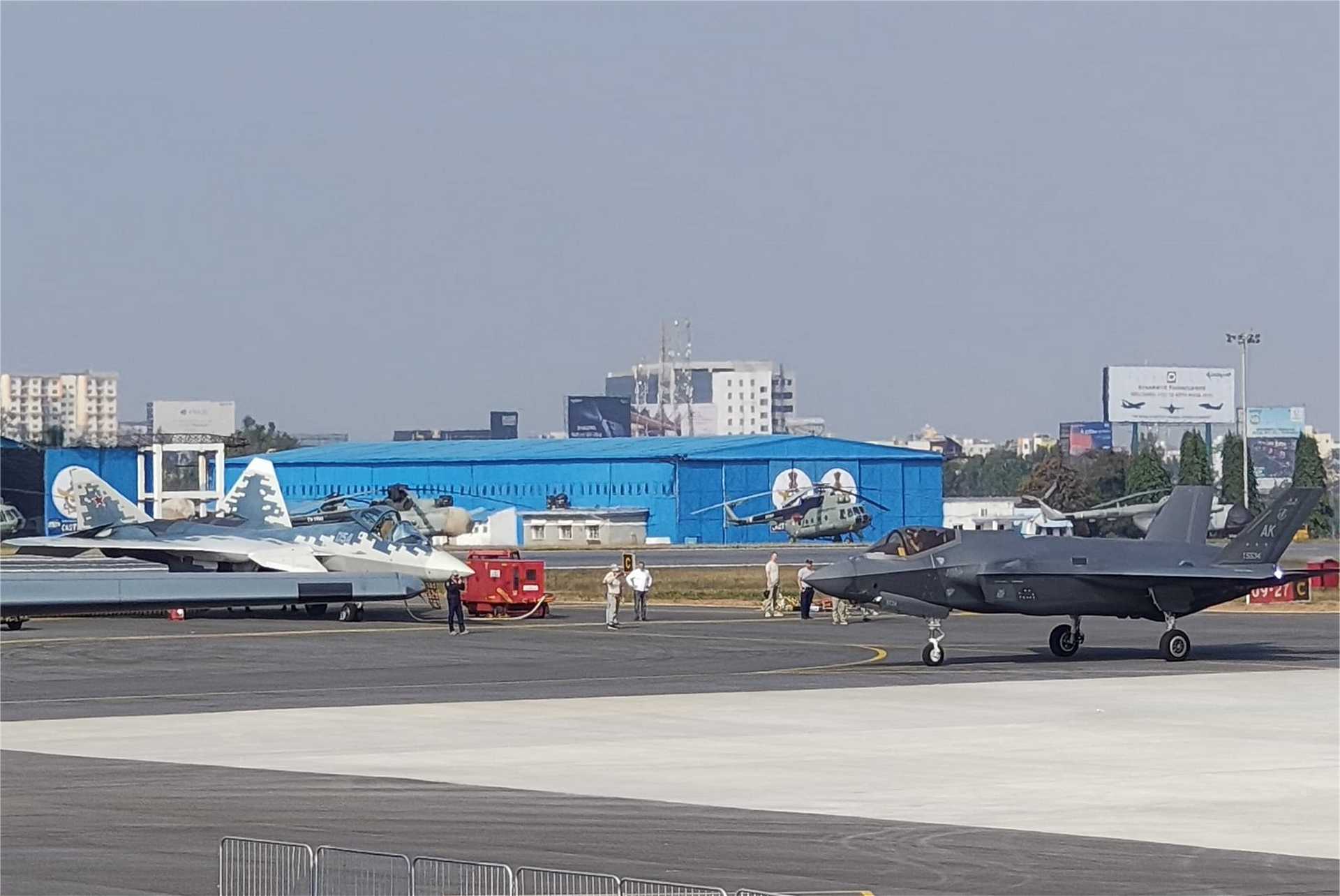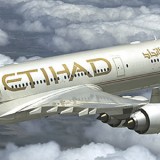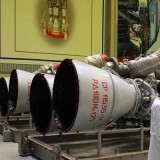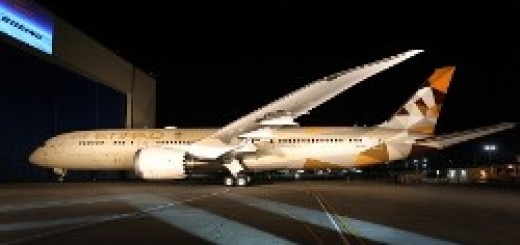Exclusive: Aero India 2025 Russian Su-57 and US F-35 Compete for Indian Air Force Next Fighter Jet

{loadposition bannertop}
{loadposition sidebarpub}
On Monday, February 10, 2025, Aero India 2025 officially begins at Yelahanka Air Force Station, marking one of the most anticipated defense exhibitions in recent history. This year’s event will feature a historic showdown between two of the world’s most advanced fifth-generation stealth fighters: Russia’s Sukhoi Su-57 and the U.S. Air Force’s F-35 Lightning II. The Su-57 is confirmed to make its debut appearance in India, while the F-35 is expected to be part of the static display, presenting a rare convergence of these advanced aircraft.Follow Army Recognition on Google News at this link
Russia’s Su-57 (left) and US F-35 (right) Face Off at Aero India 2025 as Both Jets Compete for India’s Next Fighter Acquisition. (Picture source: Open source Intel X account)
This event occurs as geopolitical competition intensifies between the U.S. and Russia over defense ties with India. In January 2025, the U.S. President Trump administration urged India to significantly increase its purchase of U.S. military technology, emphasizing Washington’s commitment to countering Russia’s long-standing dominance in India’s defense market, which has seen the delivery of large quantities of Russian military equipment over the years.
This event holds strategic significance as India evaluates options for its planned acquisition of 114 multi-role fighter aircraft, a deal that has drawn intense global competition. Russia’s participation underscores its commitment to strengthening defense ties with India, while the U.S.’s continued presence aims to deepen its defense cooperation with the country.
Russia’s Sukhoi Su-57 Felon was developed under the PAK FA (Perspektivny Aviatsionny Kompleks Frontovoy Aviatsii) program and made its first flight in 2010, entering service in 2020. Unlike most stealth fighters, the Su-57 integrates thrust-vectoring engines, allowing for exceptional maneuverability in air combat. This design philosophy reflects Russia’s emphasis on close-range dogfighting and air superiority, where agility and speed take precedence over pure stealth capabilities. The F-35 Lightning II, on the other hand, was designed by Lockheed Martin under the Joint Strike Fighter (JSF) program and first flew in 2006, entering service in 2015. Unlike the Su-57, the F-35 prioritizes stealth, network-centric warfare, and data fusion, enabling it to detect and eliminate threats before being detected itself.
A direct comparison between the two aircraft highlights key differences in their design approach. The Su-57 measures 19.8 meters in length with a wingspan of 14.1 meters, while the more compact F-35 measures 15.7 meters in length with a wingspan of 10.7 meters. The Su-57 boasts a top speed exceeding Mach 2.0 (2,450 km/h), outpacing the F-35’s Mach 1.6 (1,930 km/h), and features twin Saturn izdeliye 30 engines, compared to the F-35’s single Pratt & Whitney F135 engine. The Su-57 also integrates a 3D thrust-vectoring system, making it highly maneuverable, whereas the F-35 lacks thrust vectoring but compensates with superior sensor fusion and electronic warfare capabilities.
Stealth is a defining feature of both aircraft, but the F-35 is considered significantly stealthier due to its low radar cross-section (RCS), embedded sensors, and radar-absorbing materials. The Su-57 incorporates stealth features but retains partially exposed engine nozzles, increasing its radar signature. In terms of combat range, the Su-57 has an advantage with a range of approximately 3,500 km, whereas the F-35A’s range is around 2,200 km. Both aircraft feature internal and external hardpoints for carrying weapons, with the Su-57 equipped with a 30mm cannon and advanced hypersonic missiles, while the F-35 carries a 25mm GAU-22/A cannon and precision-guided bombs, including nuclear-capable weapons.
Technical Comparison: Russian Su-57 vs. U.S. F-35
Feature
Sukhoi Su-57 (Russia)
Lockheed Martin F-35 (USA)
Role
Air superiority, multirole, ground attack
Multirole, stealth attack, intelligence
Manufacturer
Sukhoi (United Aircraft Corporation)
Lockheed Martin
First Flight
2010
2006
Service Entry
2020
2015 (USAF F-35A)
Variants
Su-57 (single-seat), Su-57E (export)
F-35A, F-35B, F-35C
Length
19.8 meters (65 feet)
15.7 meters (51.4 feet)
Wingspan
14.1 meters (46.3 feet)
10.7 meters (35 feet)
Maximum Speed
Mach 2.0+ (2,450 km/h)
Mach 1.6 (1,930 km/h)
Engines
2 × Saturn izdeliye 30 (or AL-41F1)
1 × Pratt & Whitney F135
Stealth Design
Radar-absorbing materials, internal weapons bays, faceted airframe
Radar-absorbing materials, embedded sensors, minimal radar cross-section
Thrust Vectoring
Yes (3D vectoring, extreme agility)
No
Combat Range
~3,500 km (without refueling)
~2,200 km (F-35A)
Armament
1x 30mm cannon, internal & external hardpoints for air-to-air and air-to-ground weapons
1x 25mm GAU-22/A, internal & external hardpoints for air-to-air and air-to-ground weapons
Radar & Sensors
N036 Byelka AESA radar, L-band radar, infrared search and track (IRST)
AN/APG-81 AESA radar, Distributed Aperture System (DAS), Electro-Optical Targeting System (EOTS)
Stealth Capabilities
Lower stealth profile than F-35, optimized for reduced detection
Low radar cross-section (RCS), advanced passive detection
Networking & Data Fusion
Limited compared to F-35, but features sensor fusion
Advanced data fusion, real-time network-centric warfare capabilities
Estimated Cost
~$35–40 million per unit (Su-57E export)
~$80–100 million per unit (F-35A)
The presence of both these advanced aircraft at Aero India 2025 provides India with a rare opportunity to assess their capabilities firsthand, as the country moves forward with its plans to acquire 114 multirole fighters. This competition also plays into broader geopolitical and strategic defense collaborations. The U.S. government’s push for India to increase purchases of American military technology is part of a larger strategic effort to challenge Russia’s influence in India’s defense sector. As part of this effort, Washington has promoted co-production deals for fighter jet engines and combat vehicles, including the approval for India to produce the Stryker armored fighting vehicle under the Critical and Emerging Technologies initiative (iCET).
As India seeks to modernize its air force, the showcasing of both the Russian Su-57 and U.S. F-35 at Aero India 2025 will play a crucial role in shaping future defense partnerships. This event not only highlights India’s growing significance in the global defense market but also underscores the strategic competition between Russia and the U.S. in supplying advanced military technology to India. Whether India prioritizes the stealth and networked warfare capabilities of the F-35 or the maneuverability and combat dominance of the Su-57, the decision will significantly impact India’s air combat capabilities for decades to come.

{loadposition bannertop}
{loadposition sidebarpub}
On Monday, February 10, 2025, Aero India 2025 officially begins at Yelahanka Air Force Station, marking one of the most anticipated defense exhibitions in recent history. This year’s event will feature a historic showdown between two of the world’s most advanced fifth-generation stealth fighters: Russia’s Sukhoi Su-57 and the U.S. Air Force’s F-35 Lightning II. The Su-57 is confirmed to make its debut appearance in India, while the F-35 is expected to be part of the static display, presenting a rare convergence of these advanced aircraft.
Follow Army Recognition on Google News at this link
Russia’s Su-57 (left) and US F-35 (right) Face Off at Aero India 2025 as Both Jets Compete for India’s Next Fighter Acquisition. (Picture source: Open source Intel X account)
This event occurs as geopolitical competition intensifies between the U.S. and Russia over defense ties with India. In January 2025, the U.S. President Trump administration urged India to significantly increase its purchase of U.S. military technology, emphasizing Washington’s commitment to countering Russia’s long-standing dominance in India’s defense market, which has seen the delivery of large quantities of Russian military equipment over the years.
This event holds strategic significance as India evaluates options for its planned acquisition of 114 multi-role fighter aircraft, a deal that has drawn intense global competition. Russia’s participation underscores its commitment to strengthening defense ties with India, while the U.S.’s continued presence aims to deepen its defense cooperation with the country.
Russia’s Sukhoi Su-57 Felon was developed under the PAK FA (Perspektivny Aviatsionny Kompleks Frontovoy Aviatsii) program and made its first flight in 2010, entering service in 2020. Unlike most stealth fighters, the Su-57 integrates thrust-vectoring engines, allowing for exceptional maneuverability in air combat. This design philosophy reflects Russia’s emphasis on close-range dogfighting and air superiority, where agility and speed take precedence over pure stealth capabilities. The F-35 Lightning II, on the other hand, was designed by Lockheed Martin under the Joint Strike Fighter (JSF) program and first flew in 2006, entering service in 2015. Unlike the Su-57, the F-35 prioritizes stealth, network-centric warfare, and data fusion, enabling it to detect and eliminate threats before being detected itself.
A direct comparison between the two aircraft highlights key differences in their design approach. The Su-57 measures 19.8 meters in length with a wingspan of 14.1 meters, while the more compact F-35 measures 15.7 meters in length with a wingspan of 10.7 meters. The Su-57 boasts a top speed exceeding Mach 2.0 (2,450 km/h), outpacing the F-35’s Mach 1.6 (1,930 km/h), and features twin Saturn izdeliye 30 engines, compared to the F-35’s single Pratt & Whitney F135 engine. The Su-57 also integrates a 3D thrust-vectoring system, making it highly maneuverable, whereas the F-35 lacks thrust vectoring but compensates with superior sensor fusion and electronic warfare capabilities.
Stealth is a defining feature of both aircraft, but the F-35 is considered significantly stealthier due to its low radar cross-section (RCS), embedded sensors, and radar-absorbing materials. The Su-57 incorporates stealth features but retains partially exposed engine nozzles, increasing its radar signature. In terms of combat range, the Su-57 has an advantage with a range of approximately 3,500 km, whereas the F-35A’s range is around 2,200 km. Both aircraft feature internal and external hardpoints for carrying weapons, with the Su-57 equipped with a 30mm cannon and advanced hypersonic missiles, while the F-35 carries a 25mm GAU-22/A cannon and precision-guided bombs, including nuclear-capable weapons.
Technical Comparison: Russian Su-57 vs. U.S. F-35
| Feature | Sukhoi Su-57 (Russia) | Lockheed Martin F-35 (USA) |
|---|---|---|
| Role | Air superiority, multirole, ground attack | Multirole, stealth attack, intelligence |
| Manufacturer | Sukhoi (United Aircraft Corporation) | Lockheed Martin |
| First Flight | 2010 | 2006 |
| Service Entry | 2020 | 2015 (USAF F-35A) |
| Variants | Su-57 (single-seat), Su-57E (export) | F-35A, F-35B, F-35C |
| Length | 19.8 meters (65 feet) | 15.7 meters (51.4 feet) |
| Wingspan | 14.1 meters (46.3 feet) | 10.7 meters (35 feet) |
| Maximum Speed | Mach 2.0+ (2,450 km/h) | Mach 1.6 (1,930 km/h) |
| Engines | 2 × Saturn izdeliye 30 (or AL-41F1) | 1 × Pratt & Whitney F135 |
| Stealth Design | Radar-absorbing materials, internal weapons bays, faceted airframe | Radar-absorbing materials, embedded sensors, minimal radar cross-section |
| Thrust Vectoring | Yes (3D vectoring, extreme agility) | No |
| Combat Range | ~3,500 km (without refueling) | ~2,200 km (F-35A) |
| Armament | 1x 30mm cannon, internal & external hardpoints for air-to-air and air-to-ground weapons | 1x 25mm GAU-22/A, internal & external hardpoints for air-to-air and air-to-ground weapons |
| Radar & Sensors | N036 Byelka AESA radar, L-band radar, infrared search and track (IRST) | AN/APG-81 AESA radar, Distributed Aperture System (DAS), Electro-Optical Targeting System (EOTS) |
| Stealth Capabilities | Lower stealth profile than F-35, optimized for reduced detection | Low radar cross-section (RCS), advanced passive detection |
| Networking & Data Fusion | Limited compared to F-35, but features sensor fusion | Advanced data fusion, real-time network-centric warfare capabilities |
| Estimated Cost | ~$35–40 million per unit (Su-57E export) | ~$80–100 million per unit (F-35A) |
The presence of both these advanced aircraft at Aero India 2025 provides India with a rare opportunity to assess their capabilities firsthand, as the country moves forward with its plans to acquire 114 multirole fighters. This competition also plays into broader geopolitical and strategic defense collaborations. The U.S. government’s push for India to increase purchases of American military technology is part of a larger strategic effort to challenge Russia’s influence in India’s defense sector. As part of this effort, Washington has promoted co-production deals for fighter jet engines and combat vehicles, including the approval for India to produce the Stryker armored fighting vehicle under the Critical and Emerging Technologies initiative (iCET).
As India seeks to modernize its air force, the showcasing of both the Russian Su-57 and U.S. F-35 at Aero India 2025 will play a crucial role in shaping future defense partnerships. This event not only highlights India’s growing significance in the global defense market but also underscores the strategic competition between Russia and the U.S. in supplying advanced military technology to India. Whether India prioritizes the stealth and networked warfare capabilities of the F-35 or the maneuverability and combat dominance of the Su-57, the decision will significantly impact India’s air combat capabilities for decades to come.





